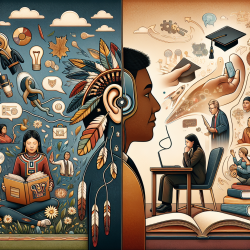As a speech-language pathologist, you are dedicated to creating the best outcomes for children. The recent research article "Nonstandard Dialect and Educational Achievement: Potential Implications for First Nations Students" sheds light on the critical role dialect plays in educational achievement. Here's how you can leverage these insights to enhance your practice.
Understanding the Impact of Nonstandard Dialects
Nonstandard dialects can include differences in pronunciation, grammar, vocabulary, and language use, which can negatively impact school achievement. For First Nations students, these differences can create barriers to academic success, particularly in environments that promote standard English.
Implementing Research Findings
Here are some practical steps to implement the research findings in your practice:
- Raise Awareness: Educate teachers and administrators about the linguistic diversity of First Nations students. Understanding that these students are not "deficient" but rather speak a different dialect can change perspectives and teaching strategies.
- Dialect-Sensitive Assessments: Use assessments that account for dialectal differences. Standardized tests often fail to recognize the linguistic background of nonstandard dialect speakers, leading to misdiagnosis and inappropriate educational placements.
- Encourage Code-Switching: Teach students when and how to switch between their home dialect and standard English. This skill can improve their academic performance and self-esteem.
- Develop Culturally Relevant Materials: Incorporate teaching materials that reflect the students' linguistic and cultural backgrounds. This approach can make learning more relatable and effective.
Encouraging Further Research
Continued research is crucial for developing effective strategies. Encourage collaboration between educators, speech-language pathologists, and researchers to gather data and develop best practices tailored to the needs of First Nations students.
By implementing these strategies, you can help bridge the educational gap for First Nations students and support their academic success.
To read the original research paper, please follow this link: Nonstandard Dialect and Educational Achievement: Potential Implications for First Nations Students.










